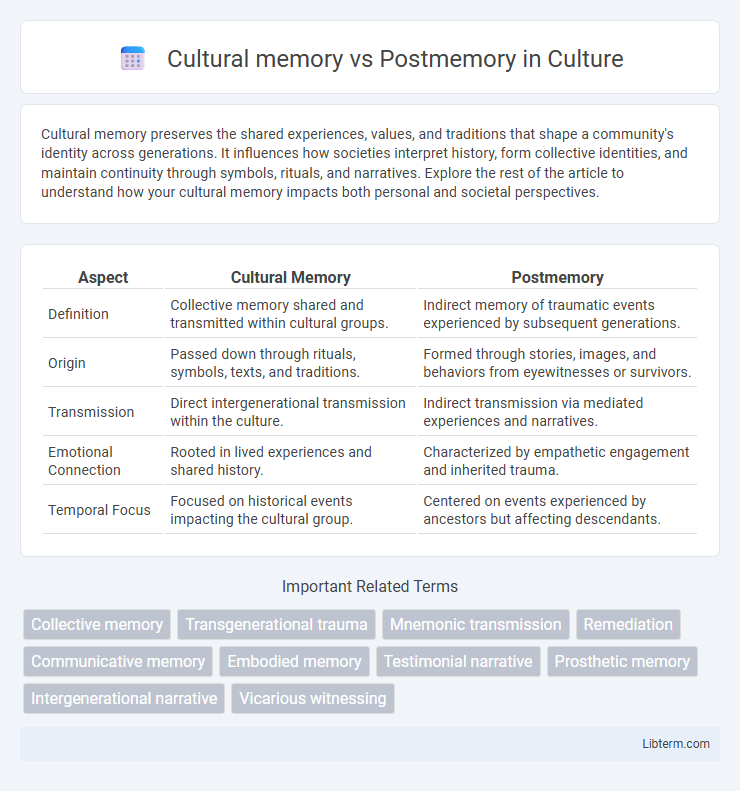Cultural memory preserves the shared experiences, values, and traditions that shape a community's identity across generations. It influences how societies interpret history, form collective identities, and maintain continuity through symbols, rituals, and narratives. Explore the rest of the article to understand how your cultural memory impacts both personal and societal perspectives.
Table of Comparison
| Aspect | Cultural Memory | Postmemory |
|---|---|---|
| Definition | Collective memory shared and transmitted within cultural groups. | Indirect memory of traumatic events experienced by subsequent generations. |
| Origin | Passed down through rituals, symbols, texts, and traditions. | Formed through stories, images, and behaviors from eyewitnesses or survivors. |
| Transmission | Direct intergenerational transmission within the culture. | Indirect transmission via mediated experiences and narratives. |
| Emotional Connection | Rooted in lived experiences and shared history. | Characterized by empathetic engagement and inherited trauma. |
| Temporal Focus | Focused on historical events impacting the cultural group. | Centered on events experienced by ancestors but affecting descendants. |
Defining Cultural Memory and Postmemory
Cultural memory encompasses collective knowledge, traditions, and practices transmitted across generations within a community, shaping identity and shared history. Postmemory refers to the relationship of descendants to traumatic experiences experienced by previous generations, particularly when direct personal memory is absent but imagination and empathy fill the gap. Both concepts address how societies remember and engage with past events, yet cultural memory emphasizes communal continuity while postmemory centers on inherited trauma and mediated recollection.
Historical Contexts of Cultural Memory
Cultural memory encompasses the shared pool of knowledge and information held by a community, shaped by collective experiences and transmitted across generations through rituals, monuments, and education. Historical contexts of cultural memory involve the ways societies remember and interpret events like wars, revolutions, or colonialism, influencing national identity and social cohesion. Postmemory, a concept introduced by Marianne Hirsch, refers to the connection of subsequent generations to traumatic events they did not directly experience but inherit through family stories, images, and cultural artifacts, highlighting the lasting impact of historical trauma on collective consciousness.
The Concept of Postmemory in Contemporary Discourse
Postmemory refers to the inherited and mediated memories experienced by generations born after traumatic events, particularly the Holocaust, shaping identity and historical consciousness. It emphasizes the gap between direct experience and indirect transmission through images, stories, and cultural practices, distinguishing itself from cultural memory, which centers on collective remembrance actively maintained by present communities. Contemporary discourse highlights postmemory's role in trauma processing, representation, and the ethical responsibility of witnessing history through subsequent generations.
Mechanisms of Transmission: Memory Across Generations
Cultural memory is transmitted through collective rituals, symbols, and shared narratives embedded in societal institutions, enabling communities to preserve historical experiences across generations. Postmemory, a term coined by Marianne Hirsch, refers to the inherited memories of traumatic events experienced by the descendants of survivors, transmitted primarily through familial stories, photographs, and artworks. Both mechanisms utilize language, imagery, and embodied practices to bridge temporal distances, shaping identity and historical consciousness beyond direct experience.
Collective Narratives: Who Shapes Cultural Memory?
Collective narratives shape cultural memory through shared experiences, rituals, and storytelling passed down across generations within a community. Cultural memory is actively constructed and reinforced by institutions such as museums, education systems, and media, which curate and disseminate dominant historical accounts. Postmemory reflects the mediated recollections of descendants who inherit trauma and memories shaped by the prior generation's direct experiences, often influencing evolving collective narratives.
Trauma, Testimony, and the Inheritance of Memory
Cultural memory encapsulates collective experiences and shared histories transmitted through rituals, symbols, and narratives that preserve trauma across generations. Postmemory, coined by Marianne Hirsch, specifically addresses the inherited memories of traumatic events experienced indirectly by descendants of survivors, manifesting through testimony, art, and storytelling. Both concepts emphasize the crucial role of testimony in bridging the gap between firsthand trauma and the intergenerational inheritance of memory, shaping identity and communal understanding.
Visual Culture: Imagery in Cultural Memory and Postmemory
Visual culture plays a critical role in shaping both cultural memory and postmemory through imagery that conveys collective experiences and inherited trauma. In cultural memory, images serve as tangible representations of shared histories, anchoring communal identity and tradition. Postmemory relies on mediated visuals--photographs, films, and art--to transmit memories from one generation to the next, often representing events not personally experienced but profoundly affecting descendants.
Literature and Intergenerational Storytelling
Cultural memory in literature serves as a collective reservoir of shared narratives and traditions that shape group identity, while postmemory refers to the inherited trauma and memories of subsequent generations that have not directly experienced the original events. Intergenerational storytelling bridges these concepts by transmitting fragmented memories and emotional truths, often reshaping history through literary representation. Writers exploring postmemory utilize techniques like fragmented narratives and testimonial voices to evoke the lingering impact of past atrocities on descendants, enriching cultural memory with personal and communal dimensions.
Challenges in Authenticity and Representation
Cultural memory involves societal transmission of shared histories, while postmemory refers to the inherited recollections of subsequent generations shaped by trauma. Challenges in authenticity arise from the tension between direct experiences and inherited narratives, complicating accurate representation. Representation struggles to balance subjective interpretation and collective memory, often risking distortion or oversimplification of complex historical realities.
Future Directions: Reimagining Memory in a Globalized World
Future directions in cultural memory and postmemory emphasize reimagining memory within a globalized world, where digital technologies and transnational narratives redefine collective remembrance. Embracing diverse cultural perspectives fosters inclusive memory practices that transcend geographic and temporal boundaries, enabling communities to negotiate identity and history dynamically. Advancements in interactive media and virtual reality offer innovative platforms for engaging with memory, facilitating more immersive and participatory experiences across generations and cultures.
Cultural memory Infographic

 libterm.com
libterm.com